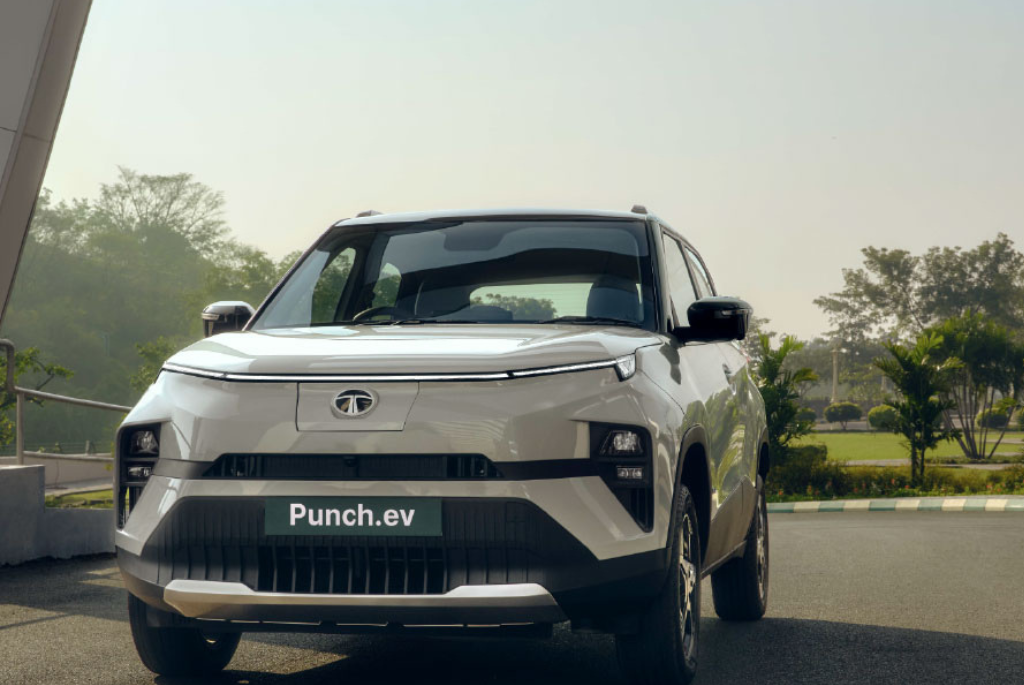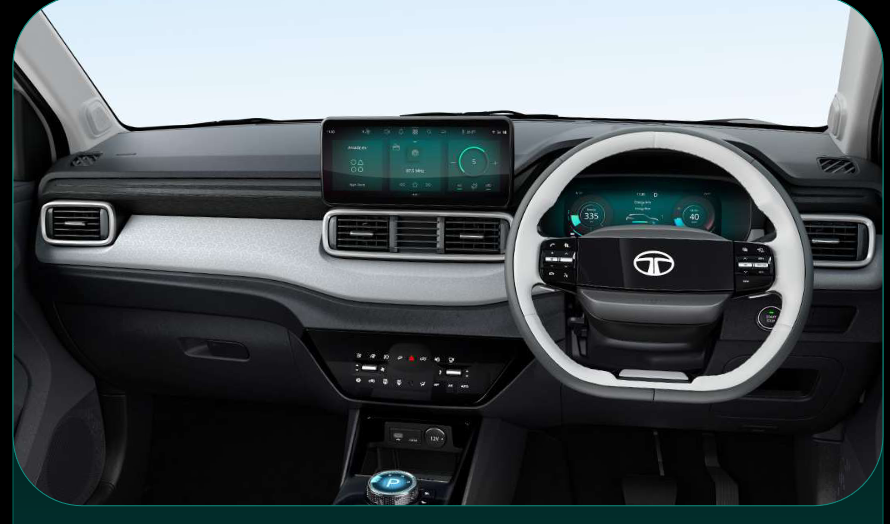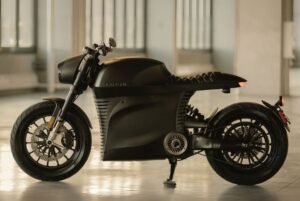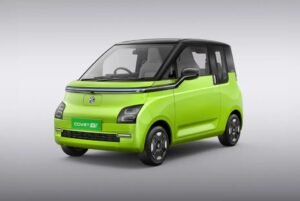
With the introduction of the Punch EV, the most reasonably priced compact e-SUV in India, Tata Motors has once again taken the EV industry by storm. It is built on the cutting-edge Acti.EV modular all-electric platform, which will also support the Harrier EV, Curvv EV, and Sierra EV.
Time-to-market and cost were important considerations. In order to move quickly, Tata Motors concentrated their efforts in areas that may not be visible but have a significant impact on the driving experience.
For example, when you pop the hood you have a front trunk (frunk)! Open the rear doors and you’ve flat floors. Nestled between the Tiago EV and Nexon EV, the Punch EV occupies a profitable niche where it competes with the likes of Citroen eC3.
Exterior: 2024 Tata Punch EV

It would seem that a completely new platform would result in a completely new style, but this isn’t the case. Since Tata Motors is sticking with the outdated Punch top hat, only minor changes were possible.
The front receives a facelift similar to that of the Nexon EV (the ICE Punch will soon sport this face, sans the jazzy lighting). All Punch EV models come equipped with LED headlamps as standard, but the higher variants get a full-width LED light bar up front that also functions as a charge indicator. The 16-inch wheels have been redesigned, and the “.ev” emblem is now located on the sides.
The only differences between the rear three-quarters and the ICE Punch are the silver bumpers and the Punch.ev lettering on the boot. The Punch appears new and “electrified” at first glance, but there is room for improvement in the back to set it apart from the regular Punch.
Interestingly, the place where you plug in the car has moved to the front, right behind the Tata logo. A cool thing is that it hides behind a panel you can pull back with just a touch of a button (and, by the way, there’s no opening for the fuel cap on the sides – pretty neat). This whole setup feels way fancier than the caps on older electric cars.
But, here’s the thing we don’t like: every time you want to charge the car, you have to open the door and reach out to the center panel to find that button. Sure, there’s a backup plan under the hood – a manual way to do it – but we think Tata Motors should’ve added a button on the car key. It would make dealing with it a lot simpler.
Interior: 2024 Tata Punch EV

The Punch EV’s interior has been completely redesigned, with a strong emphasis on technology. There are two new screens installed: one 10.25-inch screen for the infotainment system and another for the instrument cluster.
The most recent widget-based operating system is running on the infotainment, which also has OTA updates capabilities and a ton of technology, including games and Arcade.ev, an app store that lets you load streaming video and music apps.
The information is presented clearly, and the cluster can be configured with various views. It is even capable of wirelessly mirroring Google Maps (via Android Auto) or Apple Maps (via Apple CarPlay) in front of you.
The air conditioning controls are now a “phygital” panel with hard controls for temperature and fan speed in addition to touch buttons for several other functions. The steering wheel has been updated with an illuminated logo.
A flat floor is located at the back thanks to the new architecture, along with new, reasonably comfortable seats that are ventilated on the higher-end models. The gear selector is rotary. There is a ton of equipment available on the higher end trims as well, including a standard air purifier, a 360-degree camera, a sunroof, a blind spot monitor, and a wireless phone charger that is also cooled.
From what we’ve seen so far, quality seems to have improved, especially on tactile areas such as door cards and air conditioning vents. In light of the car’s footprint, storage spaces are sufficient, and the same can be said for the knee room in the back.
You definitely don’t want to be chauffeured around in this vehicle. The frunk is also new; although it is only 14 liters, it is large enough to accommodate the charging cable. The slight rocking of my car’s driver’s seat was something that did get to me. While not as bad as the Duster’s or Terrano’s from earlier, they are still noticeable when braking and accelerating.
Drivetrain, Range and Performance: 2024 Tata Punch EV
So, let’s talk about where the Punch EV keeps its power – in the floor! It’s got a totally new battery setup compared to the Nexon and Tiago. Plus, there’s just one motor hanging out on the front wheels. It’s still using LFP cells, but thanks to the new design, everything fits together better, making it more efficient.
Now, when it comes to how far it can go on a single charge, you’ve got two choices. The regular version has a 25kWh battery and claims it can go about 315 km according to MIDC standards. If you’re looking for a bit more, there’s a 35kWh option, and it says it can do around 425 km on the same test. That’s the Punch EV breaking some records!
Now, let’s dive into the motor details – the Long Range version is a powerhouse, throwing out a robust 120bhp and 190 Nm of torque. This solves a major problem the old-school Punch had – it lacked that extra oomph. Going from 0 to 100kmph, it shows off its skills in a VBOX test, clocking in at 9.5 seconds.
From the very start, you can feel the speed, and it’s got the energy we always wished the Punch had (and, by the way, its foundation could always handle it).
There are three drive modes – Eco, City, and Sport. City mode gets the job done, but when you switch to Sport, things get more exciting. The responses are quicker when you press the paddle shifters, and it accelerates with more enthusiasm, making the whole driving experience smoother. And here’s a cool feature – you’ve got four levels of regen that you can play with using the paddle shifters. You can even adjust how much the car slows down when you ease off the paddles.
One thing we were hoping for in this Gen 2 EV architecture is the ability to control how fast the car slows down when you ease off the gas pedal. In many other EVs, you can adjust the regen rate (and the corresponding deceleration) using the first part of the throttle pedal.
It’s handy, especially in the more aggressive regen modes. You can set it to the maximum regen setting and then control how much the car slows down by just easing off the throttle pedal. However, with the Tata Punch EV, the regen works just like it did before – it kicks in only when you completely release the throttle pedal. So, unfortunately, there’s no way to control the slowing down process.
When it comes to cruising at low speeds, the Punch EV is a champ. It smoothly handles bumps and potholes without breaking a sweat. No weird noises from the suspension – it’s like the Punch EV was made for this kind of road. It would be a blessing on rough city streets.
As you pick up speed, though, you might notice the suspension gets a bit firmer. On the bright side, it gives you a confident feel on smooth roads. But, be ready – bumps and uneven terrain can give the rear a tiny lift, and that might feel a bit shaky.
| Features | Standard | Long Range |
| Battery Capacity | 25 kWh | 35 kWh |
| Max Power | 80 bhp | 120 bhp |
| Max Torque | 114 Nm | 190 Nm |
| Range | 315 km | 425 km |
| 0-100 kmph | 13.5 seconds | 9.5 seconds |
| Charge Power | 3.3 kW AC | 7.2 kW AC |
| Infotainment Screen | 10.25-inch touchscreen | 10.25-inch touchscreen |
| Instrument Cluster | Digital cluster | Digital cluster |
| Frunk Space | 14 liters | 14 liters |
| Price | Rs 10.99 lakh | Rs 14.49 lakh |
Noteworthy Features:
| Apple/Android CarPlay |
| Sunroof |
| Wireless Google Maps/Apple Maps Mirroring |
| Widget-based OS |
| Arcade.ev |
| 360° Camera |
| Blind Spot Monitor |
Price and Final Verdict: 2024 Tata Punch EV
The lower range Punch sits between Rs 10.99 lakh and Rs 13.29 lakh, while the long-range version falls in the range of Rs 12.99 lakh to Rs 14.49 lakh. If you fancy a sunroof, that’s an extra Rs 50,000, and if you want the faster 7.2 kW charger, it’ll cost you another Rs 50,000.
Given this price tag, the Punch is a smart choice. It offers more value for your money compared to the Comet and Tiago EV. Unless you really need the extra space and features of the Nexon EV (considering the range difference is only 50km), the Punch stands out as the perfect option.
Our hunch is that the Punch EV is about to shake up the EV scene even more. It delivers the features we adore from the Nexon EV but in a smaller, more budget-friendly, city-ready package. The Gen 2 setup brings some serious advantages in terms of design and range.
Even though it might not scream “brand new car” from the outside, there’s a lot of innovation happening underneath. This is a major leap – the first all-electric vehicle from an Indian manufacturer! It handles well, rides smoothly, gives off a premium vibe inside, and finally, it has that punch the Punch was missing all along!


